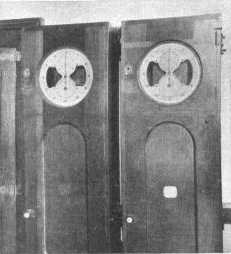Time_clocks-1905.jpg
Summary
| Description Time clocks-1905.jpg |
English:
Precision pendulum regulator clocks at the
United States Naval Observatory
in 1905 which generated the
time signal
sent out at noon every day to all parts of the US by
telegraph
lines, serving as the primary time standard used to set accurate clocks throughout the US. These two clocks were synchronized to a third precision pendulum clock, the "star clock", which was set by the time of passage of stars overhead. From the source:
|
| Date | |
| Source | Scanned from Walden Fawcett, "Distribution of Time Signals", The Technical World magazine, May 1905, p. 24 on https://earlyradiohistory.us website |
| Author | Unknown author Unknown author |
Licensing
| Public domain Public domain false false |
|
|
This media file is in the
public domain
in the
United States
. This applies to U.S. works where the copyright has expired, often because its first
publication
occurred prior to January 1, 1929, and if not then due to lack of notice or renewal. See
this page
for further explanation.
|
|
|
|
This image might not be in the public domain outside of the United States; this especially applies in the countries and areas that do not apply the
rule of the shorter term
for US works, such as Canada, Mainland China (not Hong Kong or Macao), Germany, Mexico, and Switzerland. The creator and year of publication are essential information and must be provided. See
Wikipedia:Public domain
and
Wikipedia:Copyrights
for more details.
|
Original upload log
The original description page was
here
. All following user names refer to en.wikipedia.
- 2005-05-30 16:37 Ihcoyc 245×289× (13531 bytes) Automatic [[time signal]] clocks in use in [[1905]] to coordinate time with the [[United States Naval Observatory]] by [[telegraphy]]. Scanned from a 1905 magazine, originally published to the Web at http://earlyradiohistory.us/1905tim.htm {{PD}}
Captions
Add a one-line explanation of what this file represents




